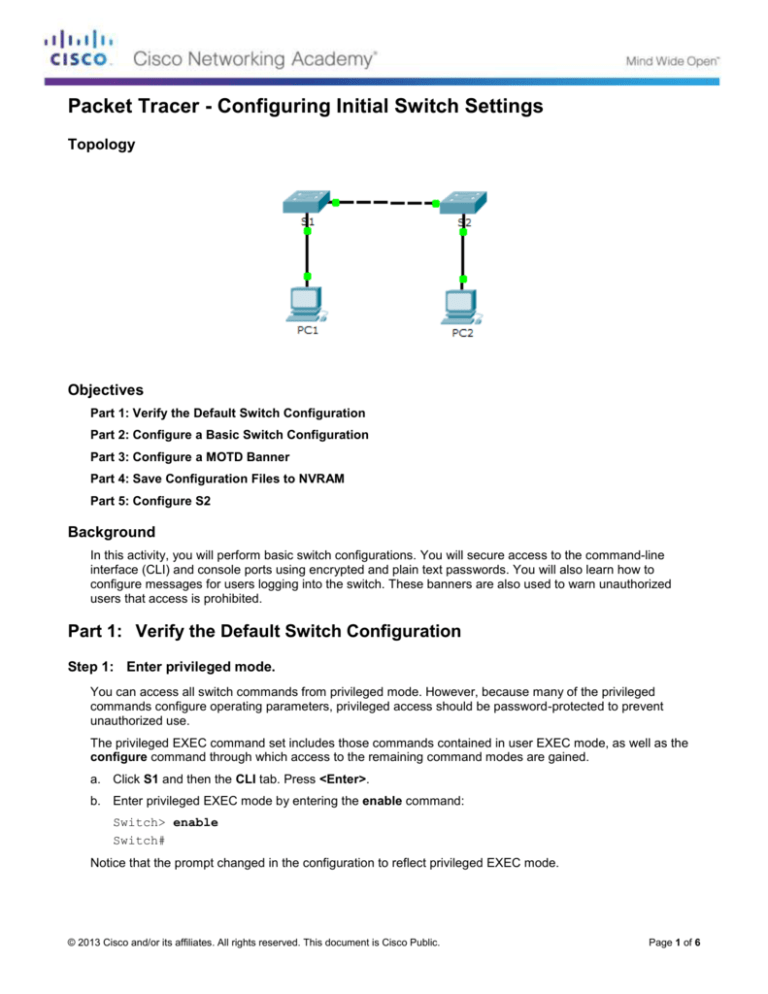
Packet Tracer - Configuring Initial Switch Settings
Topology
Objectives
Part 1: Verify the Default Switch Configuration
Part 2: Configure a Basic Switch Configuration
Part 3: Configure a MOTD Banner
Part 4: Save Configuration Files to NVRAM
Part 5: Configure S2
Background
In this activity, you will perform basic switch configurations. You will secure access to the command-line
interface (CLI) and console ports using encrypted and plain text passwords. You will also learn how to
configure messages for users logging into the switch. These banners are also used to warn unauthorized
users that access is prohibited.
Part 1: Verify the Default Switch Configuration
Step 1: Enter privileged mode.
You can access all switch commands from privileged mode. However, because many of the privileged
commands configure operating parameters, privileged access should be password-protected to prevent
unauthorized use.
The privileged EXEC command set includes those commands contained in user EXEC mode, as well as the
configure command through which access to the remaining command modes are gained.
a. Click S1 and then the CLI tab. Press <Enter>.
b. Enter privileged EXEC mode by entering the enable command:
Switch> enable
Switch#
Notice that the prompt changed in the configuration to reflect privileged EXEC mode.
© 2013 Cisco and/or its affiliates. All rights reserved. This document is Cisco Public.
Page 1 of 6
Packet Tracer - Configuring Initial Switch Settings
Step 2: Examine the current switch configuration.
a. Enter the show running-config command.
Switch# show running-config
b. Answer the following questions:
How many FastEthernet interfaces does the switch have? _______
How many Gigabit Ethernet interfaces does the switch have? _______
What is the range of values shown for the vty lines? ______________
Which command will display the current contents of non-volatile random-access memory (NVRAM)?
____________________________________________________________________________________
Why does the switch respond with startup-config is not present?
____________________________________________________________________________________
____________________________________________________________________________________
Part 2: Create a Basic Switch Configuration
Step 1: Assign a name to a switch.
To configure parameters on a switch, you may be required to move between various configuration modes.
Notice how the prompt changes as you navigate through the switch.
Switch# configure terminal
Switch(config)# hostname S1
S1(config)# exit
S1#
Step 2: Secure access to the console line.
To secure access to the console line, access config-line mode and set the console password to letmein.
S1# configure terminal
Enter configuration commands, one per line. End with CNTL/Z.
S1(config)# line console 0
S1(config-line)# password letmein
S1(config-line)# login
S1(config-line)# exit
S1(config)# exit
%SYS-5-CONFIG_I: Configured from console by console
S1#
Why is the login command required?
_______________________________________________________________________________________
Step 3: Verify that console access is secured.
Exit privileged mode to verify that the console port password is in effect.
S1# exit
Switch con0 is now available
© 2013 Cisco and/or its affiliates. All rights reserved. This document is Cisco Public.
Page 2 of 6
Packet Tracer - Configuring Initial Switch Settings
Press RETURN to get started.
User Access Verification
Password:
S1>
Note: If the switch did not prompt you for a password, then you did not configure the login parameter in Step
2.
Step 4: Secure privileged mode access.
Set the enable password to c1$c0. This password protects access to privileged mode.
Note: The 0 in c1$c0 is a zero, not a capital O. This password will not grade as correct until after you encrypt
it in Step 8.
S1> enable
S1# configure terminal
S1(config)# enable password c1$c0
S1(config)# exit
%SYS-5-CONFIG_I: Configured from console by console
S1#
Step 5: Verify that privileged mode access is secure.
a. Enter the exit command again to log out of the switch.
b. Press <Enter> and you will now be asked for a password:
User Access Verification
Password:
c.
The first password is the console password you configured for line con 0. Enter this password to return to
user EXEC mode.
d. Enter the command to access privileged mode.
e. Enter the second password you configured to protect privileged EXEC mode.
f.
Verify your configurations by examining the contents of the running-configuration file:
S1# show running-configuration
Notice how the console and enable passwords are both in plain text. This could pose a security risk if
someone is looking over your shoulder.
Step 6: Configure an encrypted password to secure access to privileged mode.
The enable password should be replaced with the newer encrypted secret password using the enable
secret command. Set the enable secret password to itsasecret.
S1# config t
S1(config)# enable secret itsasecret
S1(config)# exit
S1#
Note: The enable secret password overrides the enable password. If both are configured on the switch, you
must enter the enable secret password to enter privileged EXEC mode.
© 2013 Cisco and/or its affiliates. All rights reserved. This document is Cisco Public.
Page 3 of 6
Packet Tracer - Configuring Initial Switch Settings
Step 7: Verify that the enable secret password is added to the configuration file.
a. Enter the show running-configuration command again to verify the new enable secret password is
configured.
Note: You can abbreviate show running-configuration as
S1# show run
b. What is displayed for the enable secret password? __________________________________________
c.
Why is the enable secret password displayed differently from what we configured?
____________________________________________________________________________________
Step 8: Encrypt the enable and console passwords.
As you noticed in Step 7, the enable secret password was encrypted, but the enable and console
passwords were still in plain text. We will now encrypt these plain text passwords using the service
password-encryption command.
S1# config t
S1(config)# service password-encryption
S1(config)# exit
If you configure any more passwords on the switch, will they be displayed in the configuration file as plain text
or in encrypted form? Explain why?
_______________________________________________________________________________________
Part 3: Configure a MOTD Banner
Step 1: Configure a message of the day (MOTD) banner.
The Cisco IOS command set includes a feature that allows you to configure messages that anyone logging
onto the switch sees. These messages are called message of the day, or MOTD banners. Enclose the banner
text in quotations or use a delimiter different from any character appearing in the MOTD string.
S1# config t
S1(config)# banner motd "This is a secure system. Authorized Access Only!"
S1(config)# exit
%SYS-5-CONFIG_I: Configured from console by console
S1#
When will this banner be displayed?
_______________________________________________________________________________________
Why should every switch have a MOTD banner?
_______________________________________________________________________________________
_______________________________________________________________________________________
_______________________________________________________________________________________
© 2013 Cisco and/or its affiliates. All rights reserved. This document is Cisco Public.
Page 4 of 6
Packet Tracer - Configuring Initial Switch Settings
Part 4: Save Configuration Files to NVRAM
Step 1: Verify that the configuration is accurate using the show run command.
Step 2: Save the configuration file.
You have completed the basic configuration of the switch. Now back up the running configuration file to
NVRAM to ensure that the changes made are not lost if the system is rebooted or loses power.
S1# copy running-config startup-config
Destination filename [startup-config]?[Enter]
Building configuration...
[OK]
What is the shortest, abbreviated version of the copy running-config startup-config command? _________
Step 3: Examine the startup configuration file.
Which command will display the contents of NVRAM? ____________________________________________
Are all the changes that were entered recorded in the file? _______
Part 5: Configure S2
You have completed the configuration on S1. You will now configure S2. If you cannot remember the
commands, refer to Parts 1 to 4 for assistance.
Configure S2 with the following parameters:
a. Name device: S2
b. Protect access to the console using the letmein password.
c.
Configure an enable password of c1$c0 and an enable secret password of itsasecret.
d. Configure a message to those logging into the switch with the following message:
Authorized access only. Unauthorized access is prohibited and violators
will be prosecuted to the full extent of the law.
e. Encrypt all plain text passwords.
f.
Ensure that the configuration is correct.
g. Save the configuration file to avoid loss if the switch is powered down.
© 2013 Cisco and/or its affiliates. All rights reserved. This document is Cisco Public.
Page 5 of 6
Packet Tracer - Configuring Initial Switch Settings
Suggested Scoring Rubric
Activity Section
Part 1: Verify the Default
Switch Configuration
Question
Location
Possible
Points
Step 2b, q1
2
Step 2b, q2
2
Step 2b, q3
2
Step 2b, q4
2
Step 2b, q5
2
Part 1 Total
Part 2: Create a Basic
Switch Configuration
Part 3: Configure a MOTD
Banner
Part 4: Save Configuration
Files to NVRAM
10
Step 2
2
Step 7b
2
Step 7c
2
Step 8
2
Part 2 Total
8
Step 1, q1
2
Step 1, q2
2
Part 3 Total
4
Step 2
2
Step 3, q1
2
Step 3, q2
2
Part 4 Total
6
Packet Tracer Score
72
Total Score
100
© 2013 Cisco and/or its affiliates. All rights reserved. This document is Cisco Public.
Earned
Points
Page 6 of 6








